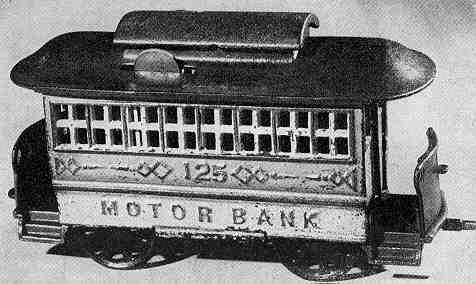Motor Bank
by F.H. Griffith - HOBBIES Magazine - December, 1952

Mechanical banks, with only about ten percent of their total number being of foreign manufacture, are definitely Americana. Their wide subject matter in the period of their manufacture recalls nostalgic thoughts of the past to many. To those who are younger, they offer an insight into an interesting period of our history. The Motor Bank is a typical example of this as it is a fairly accurate replica of the old trolley cars. Its unique action, entirely different than any of the other banks, plus its rarity and desirability rank it in the 15th position in our numerical listing.
The Motor Bank was patented in 1889 by A.C. Rex and manufactured by Alfred C. Rex and Company of Frankford, Pa. This company was originally called Kyser and Rex and continued under this name until 1884. Their line of mechanical banks made under both names of the company was an important one and they were a definite factor in this field.
The Motor Bank has also been attributed to J. and E. Stevens Company of Cromwell, Conn. It seems they acquired the patent rights to the bank, but whether or not they ever actually produced any of the motor banks is not definitely known.
The specimen pictured, which is original with no repairs, and in nice paint condition, was obtained some years ago with the help of Dr. Arthur E Corby, well known collector of New York City.
The operation of the Motor Bank and a general description of the mechanism is definitely in order in the case of this unique bank. To operate, the bank is first wound up by a key inserted on the end of a rod protruding from one end underneath the platform. The bank is then set on a flat surface and a coin is inserted and pushed into the slot located on the roof of the car. The coin trips the mechanism and the bank automatically goes forward as a bell rings inside the car.
The center-raised section of the roof is the lock-on coin trap. This is opened with a key to remove the coins. A lever on one end of the platforms disengages the gears so the bank can be played with as a regular push or pull toy. This, of course, contributes to its rarity as these banks were probably played with in and out of doors like a regular wheel toy. Consequently, the possibility of breakage was far greater in the case of the Motor Bank than with most any of the other mechanical banks.
The spring that operates the bank is wound on the rod located underneath the floor of the car between the four wheels. This rod has a gear on the end that meshes with the gear on one of the set of wheels. A ratchet arrangement inside rings the bell as the wheels revolve.
The bank is painted in attractive colors, with a red roof and yellow and green body. The platforms are red, as well as the lettering of the name. The wheels are black. The number 125 appears under the windows on each side and this apparently has no significance other than to represent the number of the car.
A desirable feature, of course, is the fact that the use of a coin is necessary to cause the bank to operate. This same feature, that is, the insertion and pushing in of the coin itself causing the action to take place by moving an inside lever, exists in a limited group of the mechanical banks. The banks in this group, along with the Motor Bank, are Panorama, Zoo Bank, Mamma Katzenjammer, Pelican, Rabbit In Cabbage, Owl (Slot In Book), Owl (Slot In Head), North Pole Bank, Bill E. Grin, Schley Bottling Up Cervera Bank, Moody and Sankey, Turtle, Bear Standing (Slot In Chest), Bowling Alley, Camera Bank, Weeden’s Plantation, and Ding Dong Bell Bank.
There are other banks whereby a coin is necessary to cause the action to take place. In this group the weight of the coin itself operates the bank, or in some cases trips the lever to start the mechanism. These will be dealt with later on in another article.
To the best of the writer’s knowledge there are four or possibly five of the Motor Banks in private collections.
It might be well to note that this bank is often referred to as the Trolley Car Bank.
